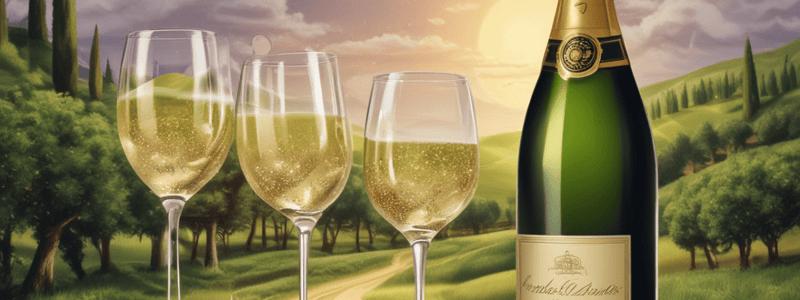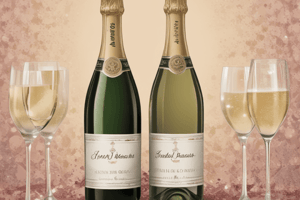Podcast
Questions and Answers
What is the primary reason Champagne can only be called Champagne?
What is the primary reason Champagne can only be called Champagne?
- Because it is made in the Champagne region in France (correct)
- Because it is made from a specific grape variety
- Because it is only produced during certain years
- Because it is made using a specific winemaking process
What is the name of the top wine from each Champagne house?
What is the name of the top wine from each Champagne house?
- Vintage
- Prestige Cuvée (correct)
- Non-Vintage
- Blanc de Blancs
What is the main difference between a Vintage and a Non-Vintage Champagne?
What is the main difference between a Vintage and a Non-Vintage Champagne?
- The sweetness level
- The aging process
- The grape varieties used
- The year the grapes were harvested (correct)
What is the term for a Champagne made only from the Chardonnay grape variety?
What is the term for a Champagne made only from the Chardonnay grape variety?
What is the term for a Champagne made from only the black/red grapes?
What is the term for a Champagne made from only the black/red grapes?
What is the primary factor that determines the colour of wine?
What is the primary factor that determines the colour of wine?
How many grape varieties are permitted in Champagne production?
How many grape varieties are permitted in Champagne production?
What is the typical labeling of most Champagnes?
What is the typical labeling of most Champagnes?
What is the purpose of malolactic fermentation?
What is the purpose of malolactic fermentation?
Where do the bottles rest quietly during the second fermentation in the bottle?
Where do the bottles rest quietly during the second fermentation in the bottle?
What is the name of the process that removes the dead yeast sediment from the bottle?
What is the name of the process that removes the dead yeast sediment from the bottle?
What is the term for a sparkling wine with 0-3 grams per liter of sugar?
What is the term for a sparkling wine with 0-3 grams per liter of sugar?
What is the name of the sparkling wine produced in Spain using local grape varieties?
What is the name of the sparkling wine produced in Spain using local grape varieties?
What is the method used to make Prosecco in North-East Italy?
What is the method used to make Prosecco in North-East Italy?
What is the term for a sparkling wine with more than 50 grams per liter of sugar?
What is the term for a sparkling wine with more than 50 grams per liter of sugar?
What is the name of the wine style that can only be produced in the legally marked area of Champagne, France?
What is the name of the wine style that can only be produced in the legally marked area of Champagne, France?
What is the name of the traditional Prosecco that is fermented in a bottle?
What is the name of the traditional Prosecco that is fermented in a bottle?
What is the method used to make sparkling wines in Franciacorta, Lombardy?
What is the method used to make sparkling wines in Franciacorta, Lombardy?
What is the name of the sparkling wine made using the ancestral method?
What is the name of the sparkling wine made using the ancestral method?
Why is it important to handle sparkling wine bottles carefully?
Why is it important to handle sparkling wine bottles carefully?
What should you do before opening a bottle of sparkling wine?
What should you do before opening a bottle of sparkling wine?
What happens when you twist the bottle while opening a sparkling wine?
What happens when you twist the bottle while opening a sparkling wine?
What is the result of opening a cold champagne?
What is the result of opening a cold champagne?
What should you have ready when opening a bottle of sparkling wine?
What should you have ready when opening a bottle of sparkling wine?
What is the primary purpose of swirling the wine in the glass?
What is the primary purpose of swirling the wine in the glass?
Which of the following is NOT a characteristic of natural wine?
Which of the following is NOT a characteristic of natural wine?
What is the main difference between organic and biodynamic wine?
What is the main difference between organic and biodynamic wine?
What is the term for a wine made from grapes that have frozen on the vine?
What is the term for a wine made from grapes that have frozen on the vine?
Which of the following is a characteristic of natural wine?
Which of the following is a characteristic of natural wine?
What is the purpose of adding sulphur dioxide to wine?
What is the purpose of adding sulphur dioxide to wine?
Which of the following wine styles is known for its rich, sweet flavor profile?
Which of the following wine styles is known for its rich, sweet flavor profile?
What is the term for a wine that has been fortified with a spirit?
What is the term for a wine that has been fortified with a spirit?
What is the effect of Botrytis Cinerea on grapes?
What is the effect of Botrytis Cinerea on grapes?
Which of the following wines is not made from Botrytis-affected grapes?
Which of the following wines is not made from Botrytis-affected grapes?
What is the characteristic of Auslese wines from Germany?
What is the characteristic of Auslese wines from Germany?
Which of the following regions is known for producing sweet red wines?
Which of the following regions is known for producing sweet red wines?
What is the characteristic of Recioto della Amarone?
What is the characteristic of Recioto della Amarone?
What is the typical flavor profile of Sauvignon Blanc?
What is the typical flavor profile of Sauvignon Blanc?
Which of the following regions is not known for producing Sauvignon Blanc?
Which of the following regions is not known for producing Sauvignon Blanc?
What is the typical pairing suggestion for Sauvignon Blanc?
What is the typical pairing suggestion for Sauvignon Blanc?
Study Notes
Wine Style: Sparkling Wine
- Champagne is a sparkling wine made from the process outlined below, and can only be called "Champagne" if it comes from the Champagne region in France.
- Types of Champagne:
- Non-Vintage (N.V.): a blend of more than one year's wines
- Vintage: made from the grapes of one year, usually an excellent year
- Prestige Cuvée: the top wine from each Champagne house
- Grape varieties used in Champagne:
- Pinot Noir
- Pinot Meunier
- Chardonnay
- Champagne production process:
- Ferment grapes as usual, usually in stainless steel, temperature-controlled tanks.
- Base wine is then blended and put in bottles with sugar and wine (liqueur de tirage).
- Second fermentation takes place in the bottle under seal.
- Bottles are rested in cool chalk cellars, then undergo riddling and disgorgement.
- Finished with a sugary wine (liqueur de dosage) and sealed with traditional cork and wire.
Labelling on Champagne and Sparkling Wine
- Brut nature, pas dosé, zéro dosage: 0-3 grams per litre (no sugar added)
- Extra brut: up to 6 grams per litre
- Brut: up to 12 grams per litre
- Extra dry: 12-17 grams per litre
- Sec/Dry: 17-32 grams per litre
- Demi-sec: 32-50 grams per litre
- Doux (sweet): > 50 grams per litre
Other Sparkling Wines
- Crémant: made in France, but not in Champagne, using the same method
- Cava: made in Spain, using local grape varieties, including Macabeu, Parellada, and Xarel-lo
- Prosecco: made in Italy, using the Glera grape variety, with second fermentation taking place in a tank
- Franciacorta: made in Italy, using the Champagne method
- Petillant Naturel (Pet Nat): made using the ancestral method, with partial fermentation in stainless steel vats and then bottled before fermentation
Organic, Biodynamic, and Natural Wines
- Organic:
- No synthetic chemicals added in the vineyard
- Permitted level of added sulphur
- Biodynamic:
- Follows a homeopathic approach using the cycles of nature and the planet
- Uses infusions of mineral, animal, and plant materials applied in homeopathic quantities
- Permitted level of added sulphur
- Natural:
- Takes organic or biodynamic practices as its starting point and extends them into the winery
- Aims to reduce chemical inputs and manipulations throughout the entire production process
- Often called "low intervention"
- Low or zero use of sulphur dioxide
Sweet Wine/Dessert Wine
- Made in different ways and varying degrees of sweetness
- Examples of sweet wine styles and regions:
- Sauternes, Barsac (Bordeaux, France)
- Jurancon (South-West France)
- Muscat de Beaumes-de-Venise (Rhone, France)
- Tokaji Aszu (Hungary)
- Ice wine (Canada, Germany, and Austria)
- Fortified wines: e.g. Port (Portugal), Sherry, Madeira
Wine Tasting
- Sight: clarity and color
- Aromas/nose: put your nose right into the glass and sniff
- Taste: swish around the palate, noting acidity, tannin, alcohol, and sweetness
- Note the finish and length
- Aroma and flavor profiles:
- Fresh fruit
- Dried fruit
- Oaky-vanilla, toast
- Vegetation
- Floral
- Buttery
- Honey
- Nutty
- Spicy
- Animal
Studying That Suits You
Use AI to generate personalized quizzes and flashcards to suit your learning preferences.
Description
Learn about the process of making Champagne and Sparkling wine, including types such as Non-Vintage, Vintage, and Prestige Cuvée.




